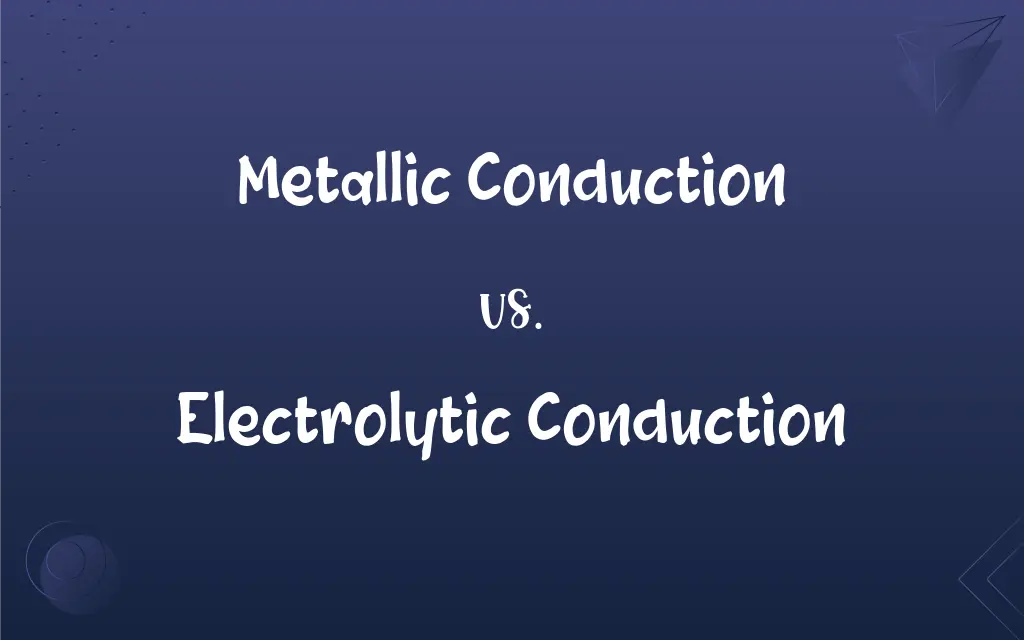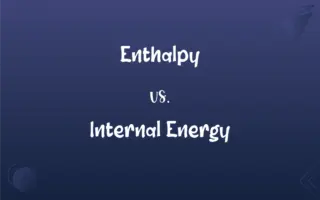Metallic Conduction vs. Electrolytic Conduction: What's the Difference?
Edited by Janet White || By Harlon Moss || Updated on October 25, 2023
Metallic conduction is electron flow through metals; electrolytic conduction is ion movement in a solution.

Key Differences
Metallic conduction involves the flow of free electrons in a metal lattice. In this type of conduction, the solid metal acts as the conductor. On the other hand, electrolytic conduction takes place when ions move through a liquid or solution, and the solution serves as the conductor.
In metallic conduction, the number of free electrons is determined by the type and structure of the metal. These electrons move under the influence of an electric field. Electrolytic conduction, however, depends on the concentration and mobility of ions within the solution, where these ions arise from the dissociation of electrolytes.
Conductivity in metallic conduction is typically higher than that in electrolytic conduction. Metals can carry higher current densities with minimal resistance. Meanwhile, electrolytic solutions have varied conductivities depending on the nature and concentration of the ions involved.
Metallic conduction does not involve any chemical changes within the material, as it's purely the movement of electrons. Electrolytic conduction, however, may lead to electrochemical reactions at the electrodes when a potential difference is applied.
Temperature can affect both types of conduction. In metallic conduction, as temperature increases, resistance generally increases due to increased lattice vibrations. In electrolytic conduction, increasing temperature usually enhances ion mobility, increasing conductivity.
ADVERTISEMENT
Comparison Chart
Medium
Solid metals
Liquid or solution
Charge Carriers
Electrons
Ions
Dependency
Metal type & structure
Electrolyte type & concentration
Chemical Changes
None
Possible at electrodes
Temperature Influence
Increases resistance
Increases conductivity
ADVERTISEMENT
Metallic Conduction and Electrolytic Conduction Definitions
Metallic Conduction
Electrical transport in metals via free electrons.
Metallic conduction ensures the efficient operation of electrical circuits.
Electrolytic Conduction
Ionic flow through a solution under an electric field.
When voltage is applied, the electrolytic conduction in the solution increases.
Metallic Conduction
Electron-based conduction in metals.
Metallic conduction in gold makes it a good conductor.
Electrolytic Conduction
Transport of charge by ions in electrolytes.
Acid solutions enable electrolytic conduction upon the addition of electrodes.
Metallic Conduction
Charge transfer via delocalized electrons in metals.
Aluminum's metallic conduction is harnessed in power lines.
Electrolytic Conduction
Conduction through dissociated ions in a liquid.
Electrolytic conduction is evident in battery solutions.
Metallic Conduction
Movement of electrons in a metal.
Copper wires utilize metallic conduction to transmit electricity.
Electrolytic Conduction
Movement of ions in a solution.
Saltwater demonstrates electrolytic conduction when electrified.
Metallic Conduction
Flow of free electrons through a metallic lattice.
Silver offers superior metallic conduction due to its free electron flow.
Electrolytic Conduction
Electrical conduction via mobile ions in solutions.
Electroplating harnesses the principle of electrolytic conduction.
FAQs
How does temperature affect metallic conduction?
Generally, as temperature increases, resistance in metals also increases.
Are metals the only materials that exhibit metallic conduction?
Primarily metals exhibit metallic conduction, but certain alloys and some non-metallic conductors can also display it.
What is metallic conduction?
Metallic conduction is the flow of free electrons through metals.
Does electrolytic conduction cause chemical changes?
Yes, especially at the electrodes, where electrochemical reactions can occur.
What determines the effectiveness of metallic conduction in a metal?
The type, structure, and number of free electrons in the metal.
Are any metals insulators in terms of metallic conduction?
All metals conduct to some degree, but some, like bismuth, have relatively poor conductivity.
What's an example of an application using electrolytic conduction?
Electroplating is an application that utilizes electrolytic conduction.
What happens to ions in electrolytic conduction?
Ions move towards respective electrodes, and can participate in electrochemical reactions.
Is the temperature effect on electrolytic conduction similar?
No, increasing temperature usually enhances ion mobility in solutions, increasing conductivity.
Can metallic conduction lead to chemical reactions?
No, metallic conduction doesn't involve chemical changes.
Are there materials that mimic metallic conduction without being metals?
Yes, certain conductive polymers and ceramics can display metallic-like conduction.
Can both metallic and electrolytic conduction occur simultaneously in a system?
Yes, for instance, in an electrochemical cell, the metal electrode has metallic conduction, while the electrolyte solution has electrolytic conduction.
Can distilled water conduct electricity via electrolytic conduction?
Not efficiently, as distilled water lacks significant mobile ions for conduction.
Do metallic conduction and electrolytic conduction require a medium?
Yes, metals for metallic conduction and liquid solutions for electrolytic conduction.
Can metals conduct via both metallic and electrolytic conduction?
In solid form, metals conduct via metallic conduction. If they ionize in a solution, they can contribute to electrolytic conduction.
Which factor influences the rate of electrolytic conduction in a solution?
The type, concentration, and mobility of ions in the solution.
Why are metals like gold and silver preferred for certain electrical applications?
Due to their superior metallic conduction properties.
Which offers higher conductivity, metallic or electrolytic conduction?
Typically, metallic conduction offers higher conductivity.
How does electrolytic conduction occur?
Electrolytic conduction occurs when ions move through a liquid or solution under an electric field.
Do all solutions demonstrate electrolytic conduction?
No, only solutions containing mobile ions (electrolytes) exhibit electrolytic conduction.
About Author
Written by
Harlon MossHarlon is a seasoned quality moderator and accomplished content writer for Difference Wiki. An alumnus of the prestigious University of California, he earned his degree in Computer Science. Leveraging his academic background, Harlon brings a meticulous and informed perspective to his work, ensuring content accuracy and excellence.
Edited by
Janet WhiteJanet White has been an esteemed writer and blogger for Difference Wiki. Holding a Master's degree in Science and Medical Journalism from the prestigious Boston University, she has consistently demonstrated her expertise and passion for her field. When she's not immersed in her work, Janet relishes her time exercising, delving into a good book, and cherishing moments with friends and family.
































































